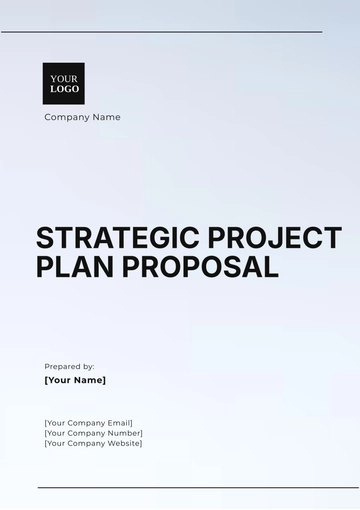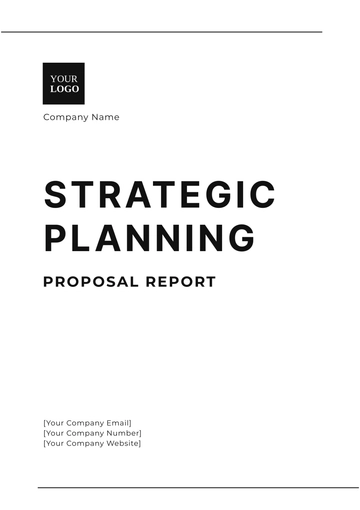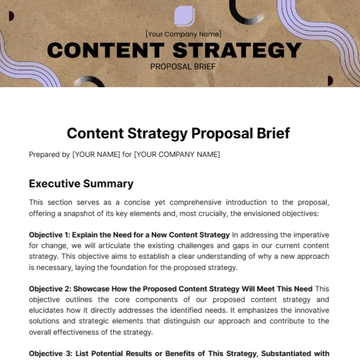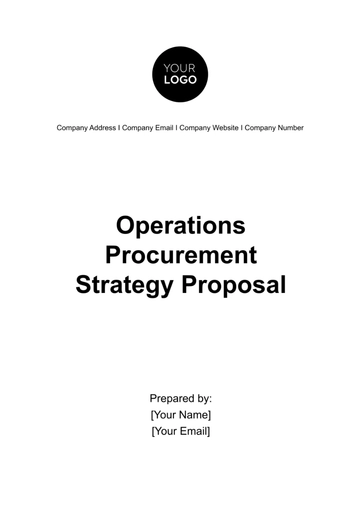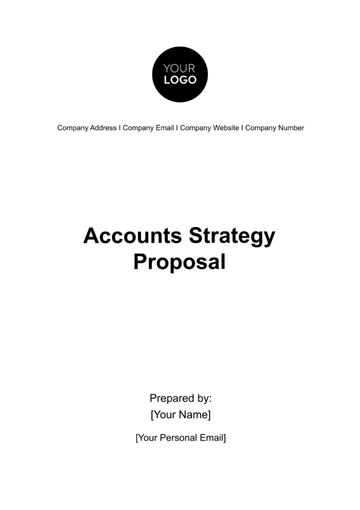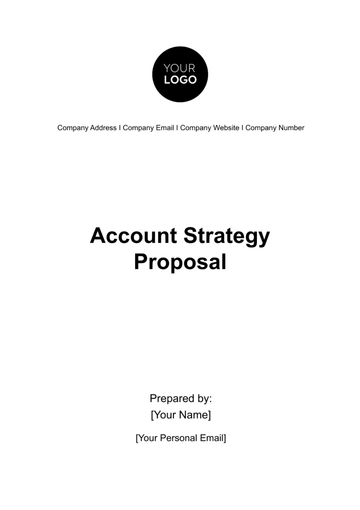Free Account Strategy Proposal

Executive Summary
This Account Strategy Proposal outlines our comprehensive plan for significantly enhancing the performance and growth of one of our key accounts over the next fiscal year. Central to this proposal is the aim to deepen our engagement with the account and increase revenue by 30%, leveraging both innovative solutions and strengthening existing services.
Our strategy encompasses a series of targeted initiatives, including the introduction of customized product offerings, a robust digital marketing campaign, and an enhanced customer engagement program. These initiatives are designed to align with the specific needs and challenges of the account, thereby creating added value and fostering deeper loyalty.
Financially, we anticipate an initial investment of $200,000 in the proposed strategies, with a projected revenue increase to $1.5 million from the current $1.15 million over the next year. This projection is based on a detailed market analysis, the account's historical performance, and our in-depth understanding of their business environment.
Risks are identified and mitigation strategies are outlined to ensure the smooth execution of the plan. We have also established key performance indicators (KPIs) to regularly measure the effectiveness of the implemented strategies and ensure they are on track to meet our objectives.
This proposal presents a strategic pathway to not only achieving significant growth with this key account but also setting a standard for excellence in account management within our organization.
Introduction
This proposal is crafted in the context of evolving market dynamics and the growing needs of one of our most valued accounts. The account in focus has been a part of our portfolio for over five years, predominantly engaging with our core product offerings. The purpose of this strategy is to proactively respond to changing market conditions and the account's evolving requirements, with an aim to foster growth, deepen customer engagement, and enhance overall satisfaction.
Our relationship with this account has been marked by consistent collaboration and mutual growth. However, the increasing competitive pressure and the account's expanding scope of operations present new challenges and opportunities. This strategy is designed to address these changes, ensuring that we continue to provide exceptional value and support to their business.
Account Overview
The account, a prominent player in the technology sector, has shown a steady growth trajectory, with an average annual revenue increase of 15% over the past three years. Our engagement has primarily been in supplying specialized software solutions and technical support services.
Historical Performance
Year 1-3: Rapid adoption of our products, with a 20% yearly increase in purchase volume.
Year 4: Plateau in purchases, signaling a need for diversification in our offerings.
Year 5: Slight decline in engagement, with a 5% drop in revenue from the account.
Current Status
Current annual revenue from the account stands at $1.15 million.
Recent feedback indicates a growing interest in more integrated, AI-driven solutions.
Key Stakeholders
The account's leadership team, including their CEO and CTO, with whom we have established strong relationships.
Key decision-makers in their procurement and IT departments.
Previous Strategies
Initial strategy focused on product introduction and establishing reliability.
Subsequent strategies included upselling and cross-selling additional services.
Recent efforts have been towards customized solutions, though with limited scope.
Market Analysis
In the fast-paced technology sector, market trends and customer insights are critical for shaping effective account strategies. Our analysis reveals several key trends that are reshaping the industry landscape. Understanding these trends, along with deep customer insights, is crucial in tailoring our approach to meet the account's evolving needs.
Trends
Rise of AI and Machine Learning: A significant shift towards AI-driven solutions in operational and customer service processes.
Increased Focus on Cybersecurity: Growing concern for data security is driving demand for advanced cybersecurity solutions.
Remote Work Technologies: The surge in remote working models is increasing the demand for cloud-based collaboration tools.
Customer Insights
The account has shown a keen interest in integrating AI technologies to streamline operations.
There is a growing concern within the account about data security and compliance with new regulations.
The account is exploring solutions to enhance remote workforce efficiency and collaboration.
Competition
Competitor | Market Share | Key Strengths | Key Weaknesses |
TechInnovate Solutions | 30% | Leading in AI integrations | Higher pricing, less flexibility |
SecureNet Technologies | 20% | Strong in cybersecurity | Limited product range |
CloudCollab Inc. | 15% | Expertise in remote work solutions | Smaller market reach |
SWOT Analysis
The SWOT analysis for our account strategy helps identify our internal strengths and weaknesses, as well as external opportunities and threats that could influence the effectiveness of our strategy.
Strengths (S) | Weaknesses (W) | Opportunities (O) | Threats (T) |
Established relationship with the account | Limited experience in AI-based solutions | Growing market for AI and cybersecurity solutions | Intense competition in technology solutions |
Strong track record in software solutions | Resource constraints for large-scale solution deployment | Increasing demand for remote work technologies | Rapid technological changes and innovations |
Robust customer support services | Current product range not aligned with emerging market trends | Potential for long-term contracts with expanded services | Shifting regulatory landscape in cybersecurity |
Objectives and Goals
The primary objective of this strategy proposal is to significantly enhance our engagement with the account and drive substantial growth. To achieve this, we have set specific and measurable goals:
Increase Revenue: Achieve a 30% increase in revenue from the account, aiming to reach $1.5 million in the next fiscal year.
Expand Product Offering: Introduce at least two new AI-driven products tailored to the account's needs.
Strengthen Customer Relationship: Enhance customer satisfaction by 25% as measured by customer feedback and retention rates.
Improve Market Positioning: Position our company as a leading provider of integrated, AI-based technology solutions in the sector.
Secure Long-term Engagement: Establish a framework for a long-term contract, ensuring ongoing collaboration and mutual growth.
These goals are designed to be both ambitious and attainable, ensuring we not only meet but exceed the account's expectations.
Strategic Initiatives
To achieve the outlined objectives and goals, the following strategic initiatives have been proposed:
Development and Launch of AI-Driven Products
We plan to develop and introduce two new AI-based products specifically designed to address the operational efficiencies and data security needs of the account. This initiative aligns with our goal to expand our product offering and increase revenue. By offering cutting-edge, tailored solutions, we aim to reinforce our market positioning and strengthen our relationship with the account.
Enhanced Customer Engagement Program
A comprehensive program will be implemented to deepen our engagement with the account. This includes regular strategy sessions, personalized support, and customized training for their team on new technologies. This initiative is crucial for achieving our goal of improving customer satisfaction and solidifying our long-term partnership. It demonstrates our commitment to not just meeting but anticipating the account's needs.
Strategic Partnership and Collaboration
We propose to establish a strategic partnership, going beyond the traditional vendor-client relationship. This involves collaborative product development, joint marketing efforts, and shared insights into industry trends. Aligning with our goal of securing long-term engagement, this initiative fosters a deeper, more integrated relationship, ensuring mutual growth and success.
Action Plan
The successful implementation of our strategic initiatives requires a detailed and well-structured action plan. This plan outlines the specific steps to be taken, the timeline for execution, and the assignment of responsibilities. It ensures that each initiative is effectively managed and progresses in line with our overall objectives.
Action Item | Month | Responsibilities |
Finalize design for AI-driven products | 1-3 | Product Development Team |
Market research for AI product feasibility | 1-2 | Marketing and Research Team |
Develop prototype for AI products | 3-4 | Product Development Team |
Initiate customer engagement program | 2 | Account Management and Customer Service |
Train staff on AI product features | 5 | Human Resources and Technical Trainers |
Launch marketing campaign for new products | 6 | Marketing Team |
Organize joint strategy session with account | 7 | Senior Management and Account Management |
Review and adjust product offerings | 8 | Product Development and Sales Teams |
Formalize strategic partnership agreement | 9 | Legal and Senior Management |
Evaluate progress and adapt strategies | 10 | All Departments |
Budget and Resource Allocation
A critical aspect of this strategy is the allocation of budget and resources to support the planned initiatives. An estimated budget has been prepared, outlining the financial investment required for each initiative and the expected revenue growth. This projection ensures that our resources are effectively utilized to achieve the maximum return on investment.
Initiative | Estimated Cost ($USD) | Expected Revenue Growth ($USD) |
AI-Driven Product Development | 100,000 | 400,000 |
Customer Engagement Program | 50,000 | 200,000 |
Marketing and Promotional Activities | 30,000 | 300,000 |
Strategic Partnership Initiatives | 20,000 | 100,000 |
Total | 200,000 | 1,000,000 |
Risk Assessment and Mitigation
Implementing any strategic initiative comes with its set of risks. Identifying these risks, assessing their potential impact, and planning for mitigation are crucial steps in ensuring the success of our strategy. We have conducted a thorough risk assessment to prepare for and mitigate possible challenges.
Risk | Likelihood | Impact | Mitigation Strategy |
Delays in AI Product Development | Medium | High | Implement agile project management techniques and set interim milestones. |
Resistance to New Products | Low | Medium | Conduct customer feedback sessions and offer trial periods to encourage adoption. |
Market Competition Intensification | High | High | Continuously monitor market trends and adjust strategies accordingly. |
Budget Overruns | Medium | Medium | Regularly review expenditures and have contingency plans in place. |
Technological Challenges | Low | High | Invest in high-quality technology solutions and skilled personnel. |
Performance Metrics and Evaluation
To effectively measure the success of our account strategy, we have identified key performance metrics and established target KPIs. These metrics will guide our evaluation process and help in making informed adjustments to our strategy.
Metric | Target KPI |
Revenue Growth | 30% increase in account revenue |
Product Adoption Rate | 50% adoption of new AI-driven products |
Customer Satisfaction Index | 25% improvement in customer satisfaction |
Market Share | Gain an additional 10% of market share |
Return on Investment (ROI) | Achieve an ROI of at least 50% |
Plan for Regular Evaluation and Adjustment
Quarterly Reviews: Conduct comprehensive reviews every quarter to assess progress against KPIs.
Stakeholder Feedback: Regularly collect and analyze feedback from key stakeholders, including the account and internal teams.
Market Analysis Updates: Continuously monitor market trends and adjust strategies to remain competitive and relevant.
Budget Reviews: Conduct bi-monthly budget reviews to ensure alignment with financial projections and objectives.
Strategy Adaptation: Based on the evaluations, adapt and refine strategies, taking into consideration new market insights and business realities.
- 100% Customizable, free editor
- Access 1 Million+ Templates, photo’s & graphics
- Download or share as a template
- Click and replace photos, graphics, text, backgrounds
- Resize, crop, AI write & more
- Access advanced editor
Drive your financial planning forward with the Account Strategy Proposal Template from Template.net. This template, crafted for strategic insight, is highly editable and customizable. Shape it to your specific business objectives using our AI Editor tool. Choose Template.net for a comprehensive and efficient approach in proposing robust account strategies that align with your financial goals.
You may also like
- Business Proposal
- Research Proposal
- Proposal Request
- Project Proposal
- Grant Proposal
- Photography Proposal
- Job Proposal
- Budget Proposal
- Marketing Proposal
- Branding Proposal
- Advertising Proposal
- Sales Proposal
- Startup Proposal
- Event Proposal
- Creative Proposal
- Restaurant Proposal
- Blank Proposal
- One Page Proposal
- Proposal Report
- IT Proposal
- Non Profit Proposal
- Training Proposal
- Construction Proposal
- School Proposal
- Cleaning Proposal
- Contract Proposal
- HR Proposal
- Travel Agency Proposal
- Small Business Proposal
- Investment Proposal
- Bid Proposal
- Retail Business Proposal
- Sponsorship Proposal
- Academic Proposal
- Partnership Proposal
- Work Proposal
- Agency Proposal
- University Proposal
- Accounting Proposal
- Real Estate Proposal
- Hotel Proposal
- Product Proposal
- Advertising Agency Proposal
- Development Proposal
- Loan Proposal
- Website Proposal
- Nursing Home Proposal
- Financial Proposal
- Salon Proposal
- Freelancer Proposal
- Funding Proposal
- Work from Home Proposal
- Company Proposal
- Consulting Proposal
- Educational Proposal
- Construction Bid Proposal
- Interior Design Proposal
- New Product Proposal
- Sports Proposal
- Corporate Proposal
- Food Proposal
- Property Proposal
- Maintenance Proposal
- Purchase Proposal
- Rental Proposal
- Recruitment Proposal
- Social Media Proposal
- Travel Proposal
- Trip Proposal
- Software Proposal
- Conference Proposal
- Graphic Design Proposal
- Law Firm Proposal
- Medical Proposal
- Music Proposal
- Pricing Proposal
- SEO Proposal
- Strategy Proposal
- Technical Proposal
- Coaching Proposal
- Ecommerce Proposal
- Fundraising Proposal
- Landscaping Proposal
- Charity Proposal
- Contractor Proposal
- Exhibition Proposal
- Art Proposal
- Mobile Proposal
- Equipment Proposal
- Student Proposal
- Engineering Proposal
- Business Proposal

